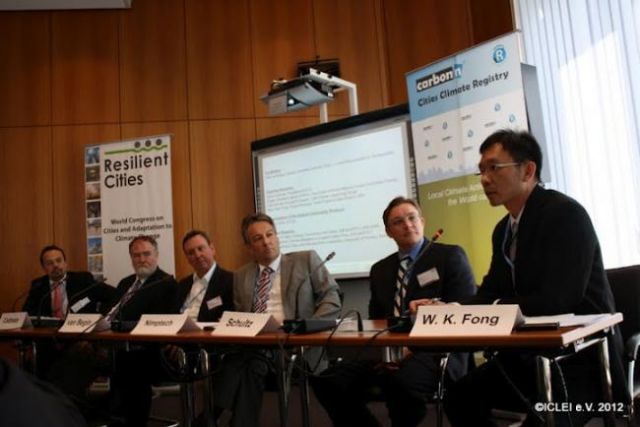
Title
By Pankaj Bhatia and Wee Kean Fong - May 18, 2012
This article was originally posted on the WRI blog, Insights.
At an official side event to the UNFCCC Bonn Climate Change Conference this week, C40 Cities Climate Leadership Group (C40), ICLEI– Local Governments for Sustainability, the World Resources Institute (WRI), and partners released Pilot Version 1.0 of the Global Protocol for Community-Scale Greenhouse Gas Emissions (GPC). The release of the GPC Pilot Version 1.0 marks an unprecedented international consensus on the greenhouse gas (GHG) accounting and reporting framework for cities and communities. For the first time, cities around the world will be able to manage and reduce their GHG impacts through a method that’s both comprehensive and easy-to-use. The GPC Pilot Version 1.0 was jointly developed by C40, ICLEI, WRI, and the Joint Work Program of the World Bank Group, UN-HABITAT, and UNEP. More than 30 expert organizations worldwide as well as city officials from Almada, Arendal, Buenos Aires, Eugene, Mexico City, Paris, Portland, Taipei, and Toronto provided inputs during the month-long public comment period from March 20 to April 20, 2012.
During the development of the draft protocol, WRI provided technical assistance to the cities of Xiaolan, China, and Rio de Janeiro, Brazil, in their pilot GHG inventories. Lessons learned from these and other cities provided important information in creating the draft protocol. In June, Xiaolan will launch its city-wide GHG inventory and become one of the first cities in the world to report its GHG emissions based on the GPC Pilot Version 1.0.
WRI and the GHG Protocol will work with C40 and ICLEI in the coming months to pilot test the draft protocol in cities around the world. The full GPC will be finalized after the pilot testing and is expected to be released by the end of 2012.
“The release of GPC Pilot Version is a very significant milestone for WRI’s Sustainable Cities Initiative,” says Jennifer Morgan, director of WRI’s Climate and Energy Program. “We are currently in discussion with the cities of Sao Paulo, Brazil, and Bangalore, India, to pilot test the draft protocol. Our ultimate goal is to help cities manage and reduce GHG emissions in order to create a more sustainable and livable urban environment.”
The draft protocol provides the most comprehensive GHG accounting and reporting framework for cities. The GPC pilot framework will provide comprehensive data that can help cities meet multiple objectives, including tracking performance, responding to regulations and requirements of local GHG programs, and building effective low-carbon strategies. The comprehensive reporting framework of GPC allows cities to easily customize the results for local reporting needs and ensure international compatibility at the same time. It also enables cities to analyze and manage their GHG emissions to address several important local objectives, including making a credible case for accessing local and international financing targeted at low-carbon development.
The IPCC outlines how countries can produce national GHG inventories, and the GPC Pilot Version 1.0 is consistent with those guidelines as well as the corporate reporting standard developed by the GHG Protocol. The draft protocol also adopts GHG Protocol’s “Scope” framework for reporting emissions (see box), a method that has been used globally for for corporate-level GHG inventories for more than a decade. Cities are required to report based on BASIC, BASIC+, and EXPANDED categories and by Scopes 1, 2, and 3 (see box). A minimum of the complete BASIC and Scopes 1 and 2 inventories are required to be in conformance with the GPC Pilot Version 1.0.
WRI, C40, and ICLEI also announced a partnership to develop and publish additional guidance in 2014 to cover all indirect emission (Scope 3) sources. The new guidance will enable cities to identify and manage their GHG emissions that occur both within and outside city boundaries. For example, to produce food for cities, farmers apply fertilizers, use machinery in their farms, and transport their goods to factories and wholesalers in cities. Then, cities’ waste from processing and food consumption is sometimes transported to landfill facilities outside the city. All of these activities emit GHGs outside of city boundaries, but they’re the result of consumption and activities occurring in cities. The additional guidance enables measuring of these indirect or Scope 3 emissions included in the GPC 2012 EXPANDED.